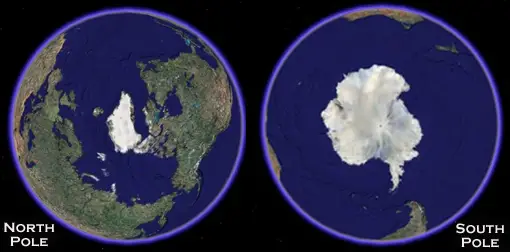What effect does global warming have on the polar caps? Global warming has many implications for the planet, but what is the effect of this process on icebergs and the ice in the Arctic or Antarctic and to the world oceans. As you have now seen global warming has many implications for the planet, but what is the effect of this process on polar caps.
The total global temperature increase between the years 1850 to 2005 is 0.76°C (1.36°F) and the rate of warming averaged over the last 50 years is nearly twice that for the last 100 years. At the poles, many areas are warming at a rate two or three times the global average. Although this rise in temperature may not sound like much it has an enormous affect, even half a degree rise in temperature can have an effect on the way the weather and planet operates. For example, the U.S. Environmental Protection Agency (EPA) notes that the sea level has risen 15 to 20 cm (6 to 8 inches) in the last 100 years. These higher temperatures are causing some floating icebergs to melt, but more importantly are affecting the polar-caps.
The full effects of global warming on the polar caps and the cryosphere are complex and not yet fully understood. We have already seen the break-up of the Larsen and Ayles Ice Shelves and the effects extend well beyond the poles themselves, and will have dramatic global implications. The warming itself may cause further accelerated warming, or a “positive feedback” . For example, the loss of sea-ice reduces albedo and changes the ability of the ocean to absorb carbon dioxide and heat. Sea level rise associated with increased flows from the ice sheets, exacerbated by immense moulins represents one of the greatest threats from human induced climatic change.
The North Pole is warming up faster than the rest of the world, with potentially devastating consequences. On Sept. 21, 2005, sea ice extent dropped to 2.05 million sq. miles, the lowest extent yet recorded in the satellite record.
Data fro the National Snow and Ice Data Center (NSIDC) in the US, show that Arctic sea ice is in a state of ongoing decline. The reason we know this is because satellites offer us a long-term record. As of September 2007, the September rate of sea ice decline since 1979 was approximately -10 percent per decade, or 72,000 square kilometers (28,000 square miles) per year. Although the 2008 sea ice minimum was slightly above the 2007 record, the rate of decline since 1979 increased to -11.7 percent per decade.
September is the month that Arctic sea ice melts back to its lowest point, known as the annual minimum, and is an important indicator of overall ice conditions. However, sea ice in the Arctic is in decline in all months and the decline is greater and the rate faster than natural causes could account for.
The NSIDC suggest that last time scientists can say confidently that the Arctic was free of summertime ice was 125,000 years ago, during the height of the last major interglacial period, known as the Eemian. Temperatures in the Arctic were warmer than now and sea level was also 4 to 6 meters (13 to 20 feet) higher than it is today because the Greenland and Antarctic Ice Sheets had partly melted. Because of the burning of fossil fuels, global averaged temperatures today are getting close to the maximum warmth seen during the Eemian. Carbon dioxide levels now are far above the highest levels during the Eemian, indicating there is still much warming to come.
In 2006, Greenland experienced more days of melting snow and at higher altitudes than average over the past 18 years, according to a new NASA-funded project using satellite observations. Not only has this implications for sea level rise, but it also risks changing the Gulf Stream’s ability to convect warm water to Northern Europe. The reasonably mild winters of Northern Europe are a direct result of the massive transatlantic ‘conveyor belt’.Dramatic shifts in ocean temperature and salinity by melting polar caps are two of a number of factors that may lead to a “Snowball Earth”.

